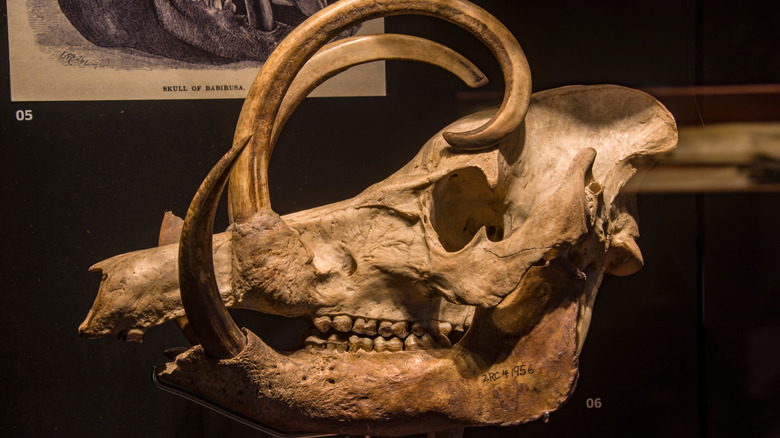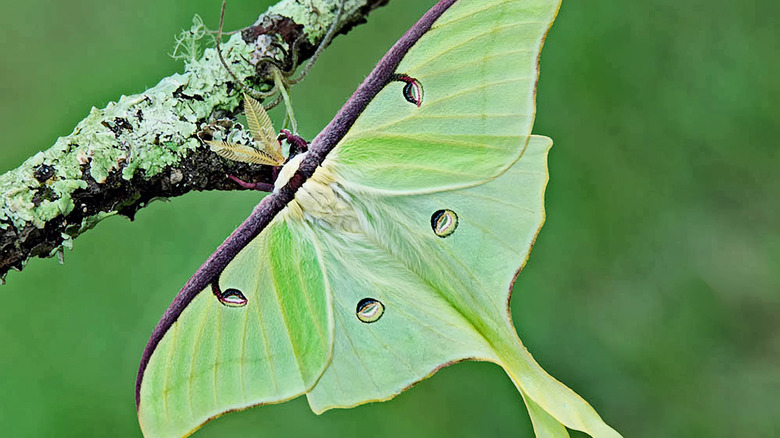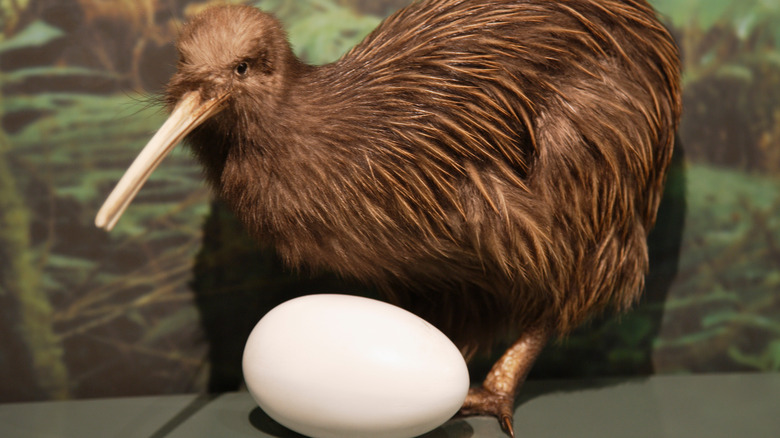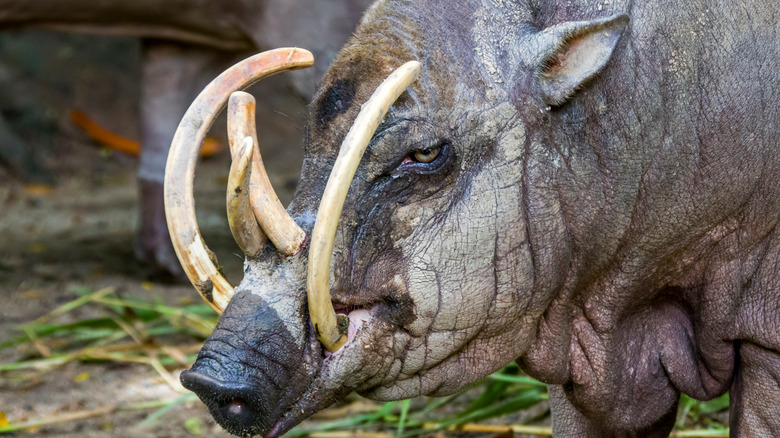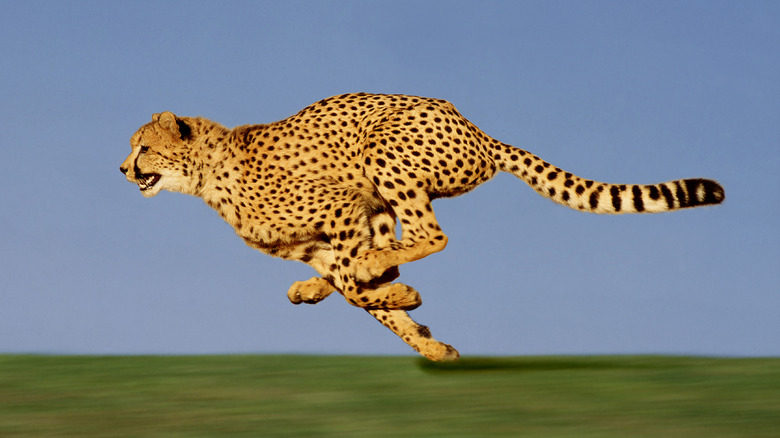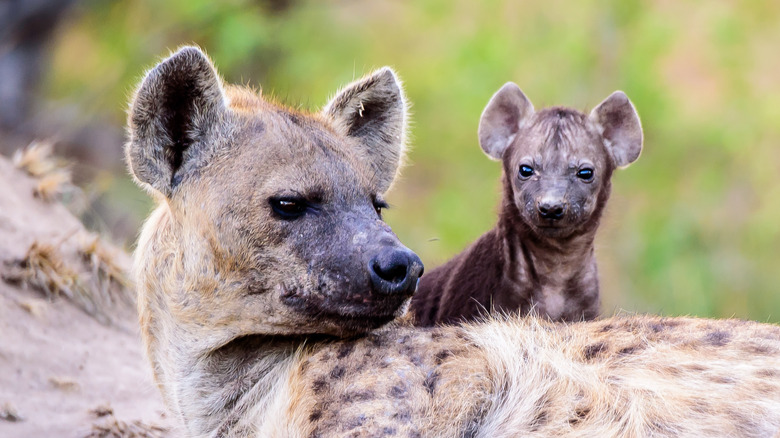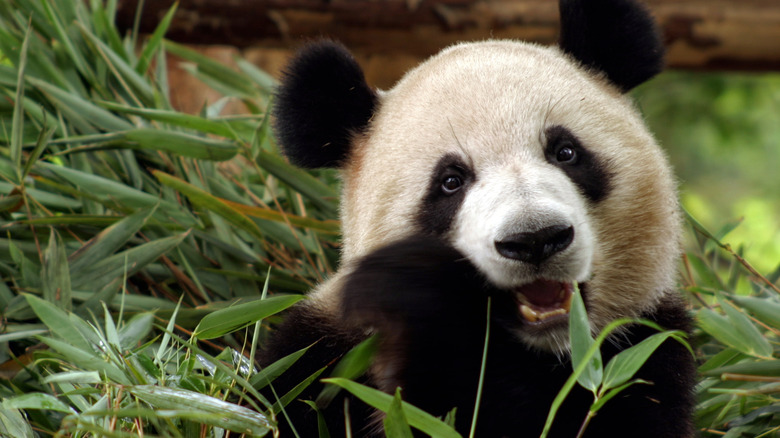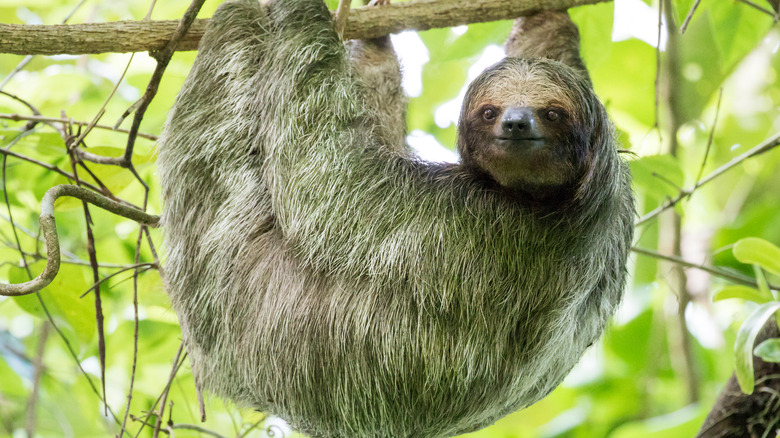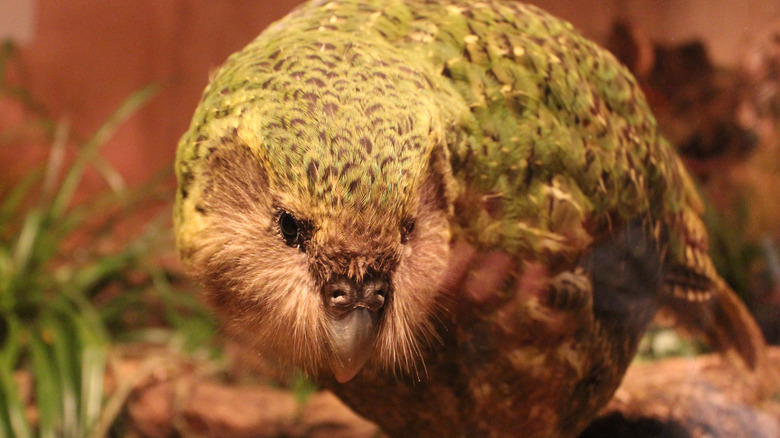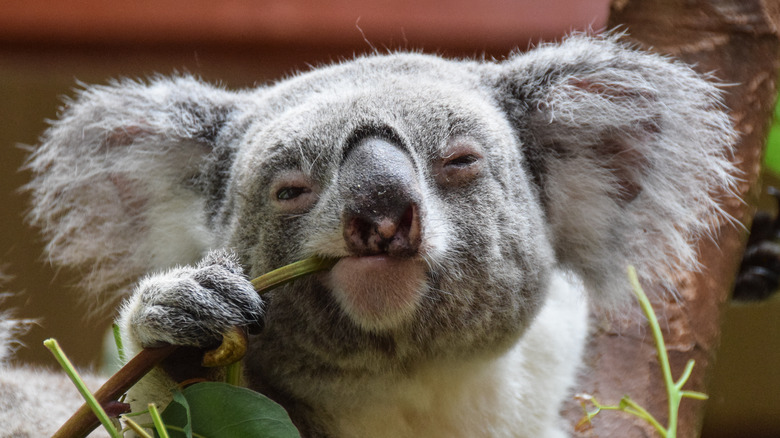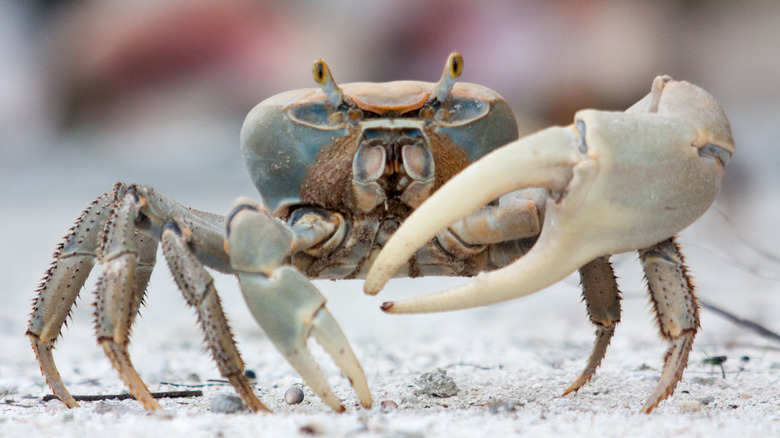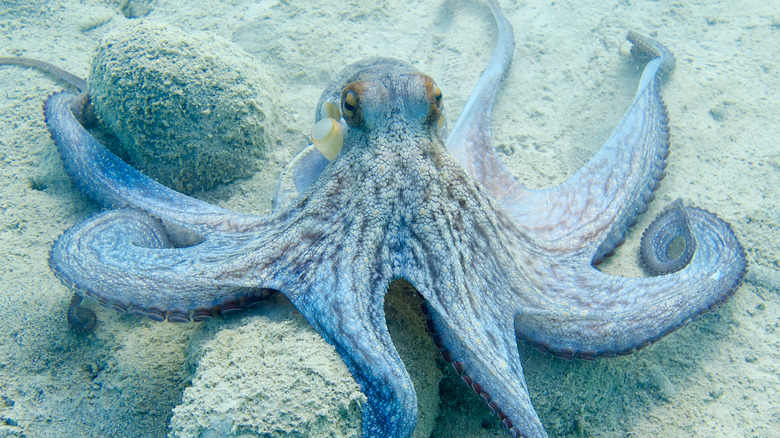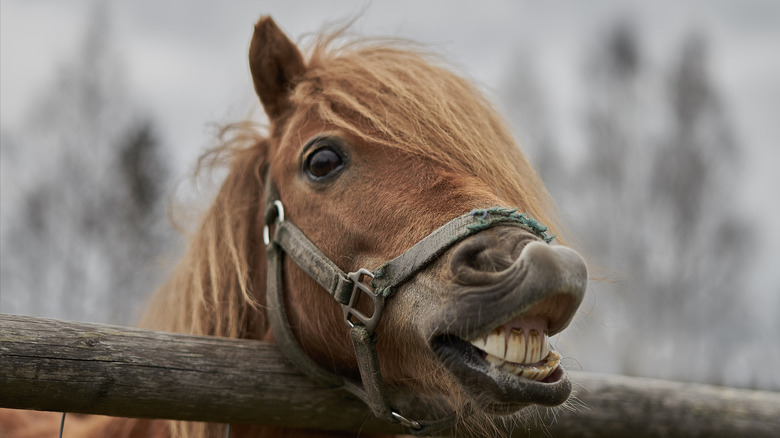The Worst Animal Evolutions In History
Evolution works in interesting ways. More often than not, it happens through natural selection. More specifically, members of a species that are able to reproduce are likely to pass on certain characteristics to their offspring — especially the ones that helped them survive and become suitable mates in the first place. That's how nature ended up with today's fast-swimming sharks, incredibly venomous snakes, and "biologically immortal" jellyfish. Of course, this is also why there are lizards that can squirt blood from their eyes and egg-laying platypus that look like duck-beaver hybrids.
Occasionally, though, you'll find examples of evolution that seem so bizarre and counterintuitive, you wonder how the poor creatures managed to live this long. That's not to say that their strange traits are completely useless; after all, they didn't get passed on from one generation to the next for nothing. However, these animals will most likely leave you scratching your head as you ponder just how they managed to pull the short end of the evolutionary stick.
Here are a few of the worst animal evolutions in history (living examples only, so you won't find things like Tyrannosaurus rex's comically tiny forearms here).
The mouthless luna moth lives only to mate
In the forested areas of North America and Canada lives the luna moth — a lime-winged lepidopteran whose only purpose in life is to reproduce. You might think that individuals of the species have to live long and receive enough nourishment to procreate with gusto. Well, not quite: As it turns out, adult luna moths only have about a week to fulfill what is literally their life's mission, meaning they have no time for things like "eating" or "having a digestive system" (via the Urban Ecology Center).
Adult luna moths sport white bodies and pink legs and can have wingspans of up to 4.13 inches. According to the University of Florida, a luna moth's mouthparts are vestigial, i.e. useless; it relies entirely on the "baby fats" it had as a caterpillar for its energy needs. From the moment its pupal stage ends, it pumps hemolymph (the arthropod equivalent of blood) to its wings to enable it to fly. A male luna moth can travel impressive distances to find its mate, and the mating ritual takes place a few hours past midnight. A female luna moth lays around 200 eggs on a suitable leaf, which will hatch after a week and a half, starting the cycle all over again.
Its inability to eat notwithstanding, the luna moth has a pretty cool ability: It can use its elongated hindwing tails to throw off echolocating bats that want to eat them (via the Florida Museum).
The kiwi: a small bird with a ridiculously large egg
Judging from looks alone, it may be hard to believe that the kiwi — a bird small enough to carry around like a chicken — has some pretty large relatives in existence. It's true, though: Just like ostriches, emus, greater rheas, and cassowaries, kiwis are ratites — a diverse group of flightless birds that may have been around since the late Cretaceous period. According to Kiwis for Kiwi, scientists aren't completely sure how kiwis came to be New Zealand natives. Regardless, New Zealand's Department of Conservation lists five different species of the bird, which the country has embraced as its symbol.
Oddly enough, kiwis have traits that are more mammalian than bird-like. As Kiwis for Kiwi explains, the kiwi has a lower body temperature than most birds, with strong, heavy, marrow-filled legs accounting for a third of its body weight. Moreover, female kiwis have two functional ovaries, unlike most avians, which have just one. Kiwis' eggs are also about six times larger than expected for a bird of its size. In fact, the pressure a kiwi egg exerts on its mother's organs is so great it can eventually make eating impossible for the parent until it lays the egg (via Te Ara).
Unfortunately, the kiwi's size and flightlessness make it an easy target for mammalian predators — particularly non-native ones. Oh, and recent studies have shown that some kiwis may be evolving blindness since their nocturnal lifestyles make vision "a waste of energy" (via New Scientist).
The babirusa's tusks can stab its own skull
In the animal kingdom, tusks can have a variety of purposes: elephants use them for digging and stripping bark, walruses use them as ice picks, and wild boars have them for defensive (and occasionally offensive) purposes. That's why the babirusa — or "pig deer" in Malay — is such an enigma. From what researchers can tell, this wild pig that lives in certain Indonesian islands doesn't use its long tusks for combat. Worse, in at least one babirusa species, the male's tusks grow in such a way that they can end up killing it (via Nature).
According to Wired, the most popular type (the self-stabbing species) is the grey-skinned, almost hairless North Sulawesi babirusa. The San Diego Zoo describes this babirusa's tusks as "canine teeth that can grow right up through the skin in their snout and curve back toward their forehead." Unless a male babirusa wears down its tusks or loses them, they will continue to grow, reportedly reaching up to 12 inches (or even more) in length. Eventually, it will pierce through the animal's skull, killing it via a terribly unpleasant self-lobotomy.
Babirusas' tusks aren't tough enough for battle; males attack each other with their front hooves while standing on their hind legs. Which raises the question: What are babirusa tusks for? Experts say that they might be signals of genetic fitness for potential mates, which sadly ensures that future generations will continue to sport the same strange tusks.
Cheetahs are super-fast and ... that's it, really
"Royalty of the cat family" sounds like an honor that belongs to the lion, given its regal reputation. However, the title actually fits the cheetah better, and not for a good reason.
As Understanding Evolution puts it, today's cheetahs are "extremely inbred," making them extremely susceptible to fatal feline diseases. Based on scientific analysis, all surviving cheetahs may have come from a handful of post-Pleistocene ancestors. At some point within the last 10,000 years, they may have experienced a sharp population reduction (also called a population bottleneck), which drastically reduced their genetic diversity. According to the Cat Specialist Group, cheetahs used to enjoy wide land distribution but are now mostly limited to certain parts of eastern and southern Africa.
Being the fastest land animal may make the cheetah's life seem like a cakewalk, but it's far from reality. For starters, the cheetah hunts during the daytime, relying on eyesight rather than smell to stalk its prey. If the chase takes too long, the cheetah stops; its speed strains the cat's body and spikes its temperature, requiring it to take a 30-minute recovery period (or longer) after difficult pursuits. Furthermore, the cheetah's bite alone isn't enough to kill gazelle or antelope — it has to chase its target, trip it, and then bite its throat to either suffocate it or puncture an artery. And it has to eat fast, as even a single hyena can take its hard-earned lunch away from it with minimal effort.
Spotted hyena births will make you wince
Spotted hyenas are perhaps best known for their peculiar vocalizations, which sound a lot like laughter to human ears. In reality, these sounds make up a complex system of communication and — depending on intensity and pitch — can mean anything from a warning to a call for help (via Science ABC). However, there's another thing that spotted hyenas are famous for, and it's hardly anything to laugh at: their difficult and dangerous way of giving birth.
According to Africa Geographic, female spotted hyenas are larger, heavier, and more aggressive than males of the species. This explains why spotted hyena clans have a single matriarch in charge and why females outrank males in these groups. Interestingly, female spotted hyenas' genitals closely resemble penises, making them "the only mammalian females to copulate, urinate, and give birth through the penile-like canal," as PBS describes. You read that right: Hyena cubs pop out from these pseudo-penises, and yes, it's as painful and brutal as it sounds.
A female spotted hyena's birth canal has a diameter of only one inch (via Business Insider). It's also not uncommon for hyena cubs to suffocate on their way out; it's said that only two in every five cubs survive this process. And it's not just the babies: first-time mother mortality rates are high, too.
The giant panda: a plant-eating 'carnivore' that's bad at sex
A cursory examination of a giant panda's daily routine makes it seem quite lazy. After all, it spends more than half of its waking hours foraging and eating; the remaining time is reserved for rest and recreation. Unfortunately, a closer look at the panda's digestive system reveals that its life is far from ideal.
Despite being classified as a meat-eater, the average panda consumes 20 to 40 pounds of bamboo daily, FlipScience says. In fact, bamboo isn't the most efficient choice for it, diet-wise. As the panda doesn't have the necessary type of gut bacteria to break down the bamboo properly, it doesn't really get as many nutrients from its hefty meal as you'd expect. In fact, about 83 percent of what it eats go straight out of its furry tush. Oddly enough, the panda's teeth, jaws, and wrists evolved over millions of years to be better suited for their peculiar dietary preferences. Furthermore, pandas' taste buds are extra adept at detecting bitter tastes — which often signify toxins — in plants (via Science).
Unfortunately, pandas aren't as talented when it comes to a different aspect of survival: reproduction. As veterinarian Pierre Comizzoli explained to VICE, female pandas can only conceive once a year, and males aren't particularly good at the deed. Perhaps unsurprisingly, conservationists sometimes have no choice but to resort to artificial insemination just to save the species.
Sloths survive by being slow (and somewhat disgusting)
According to the Smithsonian's National Zoo and Conservation Biology Institute, present-day sloths are a far cry from their gigantic ancestors. Roughly the size of a dog, these fur-covered mammals are among the slowest-moving animals known to man. In fact, they move so slow that blue-green algae grow on them. While this helps them hide from predators, the presence of algae also makes the sloth's fur a suitable habitat for all sorts of insects and parasites. And their lethargic behavior matches their metabolism, which only performs at 40% to 45% of what their weight would normally require. Scientists still aren't sure exactly how slow a sloth's digestive system works, but the estimated timeframe is astounding. Per The Conversation, it takes anywhere from six and a half days to nearly two months for a sloth to digest a single meal.
Interestingly, sloths are pretty good at swimming like dogs. Considering how they spend nearly all of their time out of the water, this ability likely helps them when they accidentally fall from their arboreal habitats.
The kakapo's defense move makes it a sitting duck for predators
Found only in New Zealand, the kakapo is a unique parrot in many ways. It's one of only two nocturnal parrots in the world, and it's the only one that can't fly. It's also the world's heaviest parrot, weighing up to nine pounds (via National Geographic). According to BBC Earth, its short wings and girth keep it grounded, but its strong legs allow it to skip around and climb trees to grab food.
This green-feathered waddler has a curious way of defending itself from predators: It stops moving completely in an attempt to camouflage itself (via Wired). Unfortunately, this defensive move doesn't work that well against the invasive mammalian species that have populated its forest habitats since European colonizers arrived in the 1800s, per a study in the Journal of Heredity. To make matters worse, the kakapo possesses a distinct "musty-sweet" odor that helps it find potential mates. Sadly, this plays to the advantage of dogs, cats, rodents, and other introduced mammalian predators that the kakapo simply didn't evolve to fight against.
It also doesn't help that the kakapo is among the slowest-breeding birds on the planet, as its reproductive cycle is based on how often rimu trees produce a bumper crop. The parrots end up mating every two to four years, and when they lay eggs, less than half successfully hatch. As of 2020, only 210 kakapos are living in the forest, based on numbers from New Zealand Birds Online.
Koalas eat poison, aren't very smart, and are kind of gross
Koalas are part of a very small circle of animals known to man capable of surviving a diet of eucalyptus leaves. While it's certainly an impressive feat, this marsupial also has some strange traits that aren't quite as awesome. For example, according to The University of Melbourne, koalas are "smooth-brained," meaning their cognitive skills aren't as sharp as most animals. Indeed, they are reportedly unable to recognize eucalyptus leaves — literally the only thing they eat — if they were lumped together on a plate.
You might even wonder why koalas bother eating eucalyptus leaves in the first place: it's incredibly tough, highly toxic, and lacking in nutrients. Over time, koalas grind down their teeth trying to chew the leaves, and when they're totally gone, the koala just dies of starvation. The Australian Koala Foundation explains that a koala's digestive system is designed to handle the leaves' toxicity and that they can even tell which types of eucalyptus are too poisonous to eat. However, since eucalyptus leaves aren't exactly great sources of energy, koalas move slowly and are typically awake for only four hours a day.
Koalas have a highly effective poison-eliminating system, but it doesn't discriminate. Thus, even life-saving antibiotics get flushed out of its body quickly (via National Geographic). Oh, and koalas are particularly vulnerable to chlamydia, and can even pass the disease on to humans (via Live Science).
The fiddler crab's impressive claw is often its undoing
With its enormous claw, the male fiddler crab cuts a silhouette so iconic it inspired a Pokémon. Experts believe that having a colossal pincer helps fiddler crabs win fights and appear to be more viable mates. But according to Gizmodo, this unique characteristic causes more problems than it solves for the crab. As University of Texas researcher Dr. Zachary Darnell stated: "The large claw is metabolically costly, it hinders feeding because it is cumbersome for this task, and it reduces endurance capacity when crawling on the sand. Male crabs are both heat-stressed and hungry while on the surface, foraging and performing the claw-waving display." Interestingly, Darnell added that the bigger claw functions as the crab's thermoregulator, as its body heat travels to its major claw and dissipates into the air.
While having a disproportionately massive claw can be both a bane and a boon for the crab, being dishonest about it can get the crustacean into serious trouble. As Science Daily explains, a fiddler crab replaces its lost major claw with a flimsier, toothless claw that's nowhere near as strong. The crab is then able to bluff its way out of fights by looking like it's capable of delivering a beatdown — that is, unless a rival male actually challenges (and inevitably defeats) it.
Octopuses are smart — but aren't exactly built to survive
With its surprising degree of intelligence, excellent camouflage skills, and regenerative abilities, the octopus seems exactly like the sort of animal that would take over the planet if humans were to one day suddenly disappear. Unfortunately, they're simply not built for world domination — literally and figuratively.
First, octopuses don't live very long; Live Science places the lifespan of the average octopus somewhere between six months and a few years. Additionally, without their impressive cognitive abilities, their lack of any protective covering makes them easy targets for marine apex predators. Furthermore, the reproductive process sucks for both male and female octopuses. Different types of octopuses disperse their sperm via a specialized arm called a hectocotylus. This arm plugs into their mate's mantle cavity, and in some cases, they end up losing the arm. It's downhill from there, as the male octopus either expires some time after mating. In rarer cases, it gets strangled and eaten by its mate, Discover Magazine reports. And females don't have it much easier, as they lay large clusters of eggs and just stop eating entirely. In other words, any octopus offspring that survive are immediately welcomed by the corpses of their dead mothers (via Science Daily).
Horses got seriously screwed over by evolution
You're probably thinking, "Wait, why horses?" After all, they have a long history of being strong and reliable steeds, whether for travel, athletic, or recreational purposes. Sadly, there's abundant evidence suggesting that horses got the short end of the evolutionary stick.
To start, horses have highly specialized breathing systems to accommodate their respiratory needs (via The Horse). Unfortunately, this means that horses are obligate nose-breathers, as they can't use their mouths to take in oxygen. Thus, any obstruction in their nose can easily end them. Furthermore, an overworked horse can suffer from exertional rhabdomyolysis, which can cause muscle pain, muscle necrosis, and eventual kidney damage (via MSD Manual). Horses also don't have the ability to vomit, and the ability to throw up is crucial for animals to expel ingested poisons from their bodies, per Equus Magazine.
Given how a horse can weigh up to 2,000 pounds, a simple leg injury can be lethal. As veterinarian Jenny Hall explained to The Guardian: "[A horse's leg bones are] very strong ... yet they're light, for them to be able to go fast. So, unfortunately, sometimes, when they break, they just shatter." And because there's very little soft tissue around the horse's leg bone, a fracture almost always punctures the skin, damaging its nerves and blood vessels and causing tissue death. In most cases, horses that suffer from leg injuries have to be put down. Makes you think twice about riding one, no?
